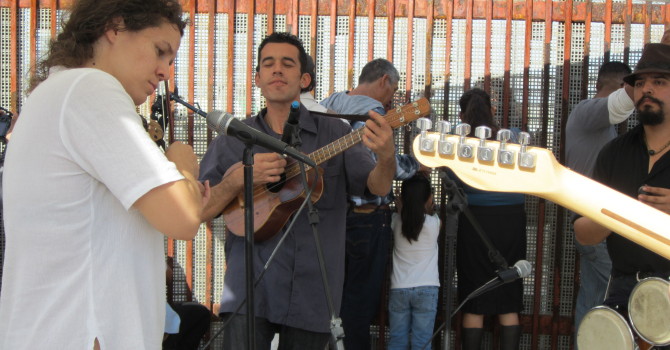Last December, I organized a binational concert at the San Diego/Tijuana border wall featuring violinist Jennifer Curtis. Here’s the story, from the Oxford American’s blog:
Despite its cheerful name and oceanic view, Friendship Park—the swath of land where San Diego meets Tijuana—has also been deemed the “most heartbreaking place in America.” If you approach on the northern side, you’ll make a forty-minute hike through California’s Border Field State Park, before entering what appears to be a prison yard where Border Patrol agents mill about. There, two eighteen-foot steel walls loom ahead, though if you arrive during “visiting hours”—10 A.M. to 2 P.M. on Saturdays and Sundays—you’ll be granted passage into the smaller park inside, joining dozens of families who have traveled tens or thousands of miles in hopes of catching a distorted glimpse of their loved ones through the steel mesh that divides the United States and Mexico. Mothers and sons, husbands and wives lean against steel, attempting to connect through the international borderline. Quietly, they murmur into each other’s ears. They stroke each other’s fingertips through the fence—perhaps experiencing their first bodily contact in years.
Not long ago, Friendship Park was a joyful place. First Lady Pat Nixon inaugurated it in 1971 after ordering her security team to snip the barbed wire fence that used to separate San Diego from Tijuana. “I hope there won’t be a fence here too much longer,” she told the crowd. For decades afterward, the park was one of the only places where Mexicans and Americans could meet document-free in the borderlands. Families would spread out beach blankets and swap tamales and kisses between the gaps in the fence as their children splashed in the nearby Pacific.
But once Congress passed the 2006 Secure Border Fence Act, the U.S. government began a series of renovations resulting in the current double wall that would have closed the park entirely if local activists hadn’t intervened.
“A lot of organizations galvanized, and we launched demonstrations against the plan,” said Rev. John Fanestil, a member of the group Friends of Friendship Park. “The years 2009 to 2011 were just horrible; the Border Patrol wouldn’t let anyone inside the park. People would drive thousands of miles to visit their families and be stopped a hundred feet away at the gate.”
After securing rights for weekend visitations, activists began working toward restoring the park’s humanity by transforming the eighteen-foot barricade into a stage for binational poetry readings, dance performances, yoga classes, volleyball games, and ecumenical communions. Their signature event is the Fandango Fronteriza, which draws hundreds of musicians to the wall each May for a jam session. When I shared footage from the event with master violinist Jennifer Curtis of Chapel Hill, North Carolina, she vowed: “I am so playing there.”
For the rest of the story, click here. Saludos!



What a touching story!